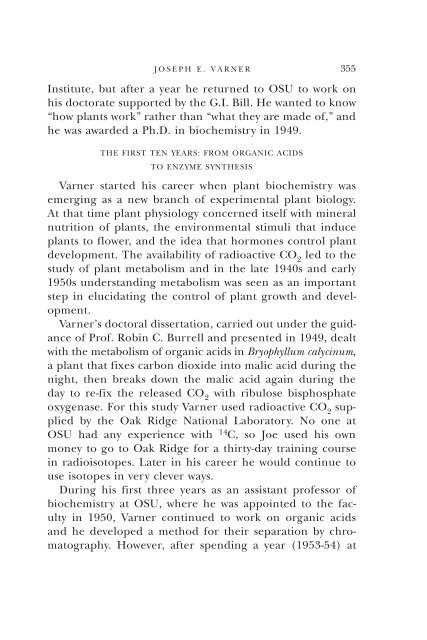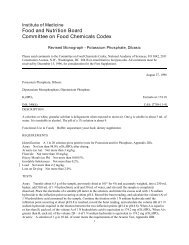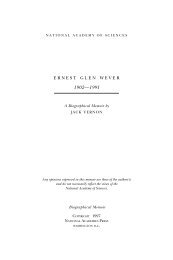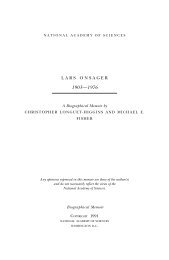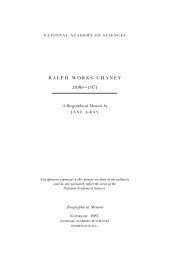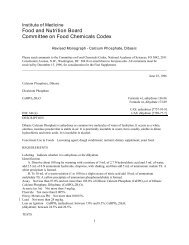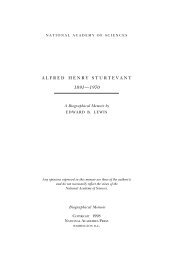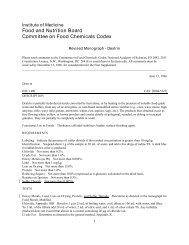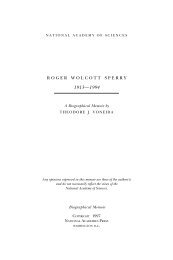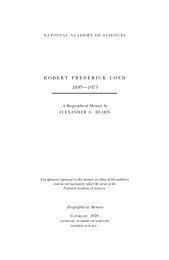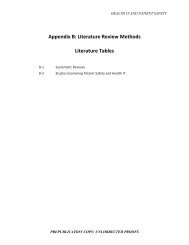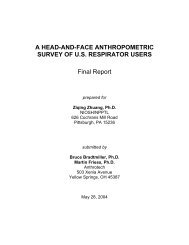JOSEPH E. VARNER - National Academy of Sciences
JOSEPH E. VARNER - National Academy of Sciences
JOSEPH E. VARNER - National Academy of Sciences
Create successful ePaper yourself
Turn your PDF publications into a flip-book with our unique Google optimized e-Paper software.
<strong>JOSEPH</strong> E. <strong>VARNER</strong><br />
355<br />
Institute, but after a year he returned to OSU to work on<br />
his doctorate supported by the G.I. Bill. He wanted to know<br />
“how plants work” rather than “what they are made <strong>of</strong>,” and<br />
he was awarded a Ph.D. in biochemistry in 1949.<br />
THE FIRST TEN YEARS: FROM ORGANIC ACIDS<br />
TO ENZYME SYNTHESIS<br />
Varner started his career when plant biochemistry was<br />
emerging as a new branch <strong>of</strong> experimental plant biology.<br />
At that time plant physiology concerned itself with mineral<br />
nutrition <strong>of</strong> plants, the environmental stimuli that induce<br />
plants to flower, and the idea that hormones control plant<br />
development. The availability <strong>of</strong> radioactive CO 2<br />
led to the<br />
study <strong>of</strong> plant metabolism and in the late 1940s and early<br />
1950s understanding metabolism was seen as an important<br />
step in elucidating the control <strong>of</strong> plant growth and development.<br />
Varner’s doctoral dissertation, carried out under the guidance<br />
<strong>of</strong> Pr<strong>of</strong>. Robin C. Burrell and presented in 1949, dealt<br />
with the metabolism <strong>of</strong> organic acids in Bryophyllum calycinum,<br />
a plant that fixes carbon dioxide into malic acid during the<br />
night, then breaks down the malic acid again during the<br />
day to re-fix the released CO 2<br />
with ribulose bisphosphate<br />
oxygenase. For this study Varner used radioactive CO 2<br />
supplied<br />
by the Oak Ridge <strong>National</strong> Laboratory. No one at<br />
OSU had any experience with 14 C, so Joe used his own<br />
money to go to Oak Ridge for a thirty-day training course<br />
in radioisotopes. Later in his career he would continue to<br />
use isotopes in very clever ways.<br />
During his first three years as an assistant pr<strong>of</strong>essor <strong>of</strong><br />
biochemistry at OSU, where he was appointed to the faculty<br />
in 1950, Varner continued to work on organic acids<br />
and he developed a method for their separation by chromatography.<br />
However, after spending a year (1953-54) at


